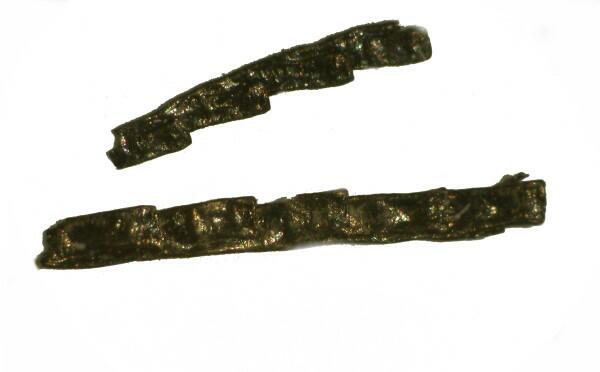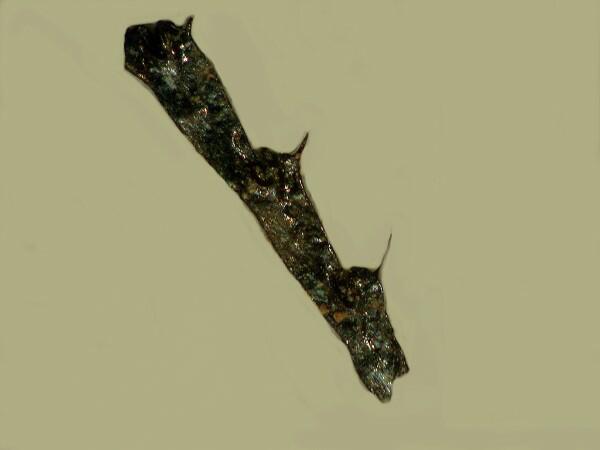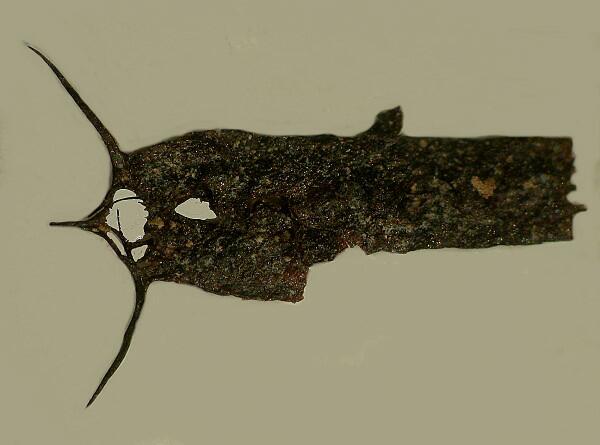
|
Grappling With Graptolites by Richard L. Howey, Wyoming, USA |
Australians and Floridians wrestle with crocodiles and alligators, so why shouldn’t we grapple with graptolites? Well, there are a couple of problems: 1) they are almost always quite small and 2) they are all extinct with a couple of possible exceptions and their fossils are mostly quite fragile and highly flattened. I can hear you saying: “O.K., O.K., but what are they?” Let me show you a couple of pictures.


So, this should clear everything up, right? (Just kidding.) The fascinating thing is that paleontologists have been disputing about what these creatures were since they were first discovered and they have been moved around the phylogenetic tree repeatedly. Many of them, such as those above, are found on black shales and frequently have a silvery appearance. They look rather like a very young child had been playing with a graphite pencil and trying to draw primitive plants or spiders with leafy legs or miniature saw blades. Other specimens, fortunately, have been preserved differently and we can get a different set of insights into the structure of these strange animals. Yes, they are animals.

This fragment belongs to an organism which has been given the imposing name Dicellograptus forchammeri. Furthermore, these are colonial animals wherein it is thought that the individuals were connected to one another by means of strands of tissue. They are exclusively marine and are now generally regarded as belonging to the hemichordates which is a phylum consisting of some other very weird creatures which is, of course, why I am writing about graptolites–the stranger the organisms, the more intrigued I become. The hemichordates are very high on the evolutionary scale of invertebrates, but not all investigators accept that they belong there and some argue that graptolites are related to an odd group of corals and are thus rather low on the evolutionary scale.
The “skeleton”, however, is not calcareous and consists of tough, fibrous proteins and is similar to collagen found in some vertebrates. In many species, there is branching which creates an appearance quite similar to certain fossil and living bryozoans and hydroids. Other graptolites have quite different shapes, some net-like, some fern-like, and others like pieces of sponge. Still others, look like flattened plant lice. Seeing the relationships between all of these bizarre forms is indeed a challenge. These creatures lived about 300 to 600 million years ago, so they had 300 million years to evolve and develop in some deeply weird ways. Their nearest living relatives–probably–among the hemichordates are also quite bizarre creatures. There are two classes of living hemichordates, the Enteropneusta or the so-called “acorn worms” and the Pterobrachia which are quite different and have only about 25 living species. It is thought that it is this group that the graptolites are related to. Whereas the Pterobrachia are usually attached to debris, the graptolites are thought to have been almost exclusively planktonic.
A major problem in studying graptolites is that most of the fossils are fragmentary. When the organisms died and slowly sank to the bottom, they were frequently broken apart by strong currents and other disturbances. They drifted down, sometimes great distances, where they were gradually covered by mud and other debris. Their often fragmentary character combined with the extensive diversity of structure makes it very difficult to get a well-grounded notion of what these creatures were like, not only in appearance, but in their physiology, internal morphology, and their behavior. The soft parts of these organisms are almost never preserved. This is one of the reasons why the search for living relatives is so crucial; the more parallels that can be drawn from living organisms, the better, because with the living forms, analogous structures may reveal clues to behavior and physiology.
There is, believe it or not, a marvelous book devoted to graptolites containing 138 full page photographs!, a glossary, a bibliography, a list of places to look for graptolites, a short chapter discussing some of the major investigators of graptolites, and 14 chapters on various aspects of these organisms ranging from general discussions suitable for the curious amateur to quite technical discussions of the morphology and preparation techniques. These photographs are especially important, because they provide an excellent sense of the weirdness and diversity of these creatures. The volume was published in 1991 and is now out of print. It is titled” Graptolites: Writing in the Rocks, edited by Douglas Palmer and Barrie Rickards, The Boydell Press, Woodbridge, Suffolk. It is an excellent volume and I highly recommend trying to find a copy in a university library if, for no other reason, than to look at the photographs. However, if you become obsessed with these incredible creatures and decide you must have your own copy of this book, there are a few copies floating around in the Internet ranging in price from $69 to $171 (plus shipping, of course).
This work, both implicitly and explicitly, raises a number of important issues about the practice and presentation of scientific research. All too often, there is an enormous gulf between scientific books that present accounts directed at amateurs and educated laymen and books that “reveal” the “real, hardcore,” “cutting edge” research that only “experts” can understand. I grant the need for technical terminology, extraordinarily fine distinctions, and in some disciplines, the need for sophisticated mathematics. However, in most instances, I don’t think that difficult ideas require obscure and esoteric modes of expression. A friend of mine is a distinguished theoretical physicist who concentrates on space-time problems and he once told me that if he couldn’t explain what he was working on to his wife–who is an intelligent and well-educated person, but not a scientist–then he hadn’t gotten it right and had to go back and rethink it until he could get it clear.
In my own discipline of philosophy, I used to get exceptionally exasperated with thinkers who seemed to think that being obscure meant that they were being profound because, for one reason, they were a terrible influence on students. It is essential that students and academics of all stripes constantly strive for clarity. To write in such a way as to make your subject matter interesting, even intriguing, wouldn’t hurt either. Too many academics ignore or dismiss the issue of style, in part, because many of them are incapable of it. So, as the philosopher H.H. Price argued in his essay “Clarity Is Not Enough,” there are indeed other aspects to the process of communicating complex ideas, but certainly a basic foundation of clarity is a giant step forward.
Sometimes I think that academic writing should have a set of labels that are like those that government uses: Restricted, Classified, Highly Classified, Secret, Top Secret, For Your Eyes Only, Cosmic Top Secret, and For Solipsists Only. The academic hierarchy might read something like this: Cliff’s Notes Level, Written for a Minor Regional Conference, Written for a National Conference, Written for an International Conference (with skiing vacation included), Written for Tenure, Contains Deconstructionist or Post-Modernist Content, Published in a Minor Journal, Published in a Major Journal, Book Published by a Vanity Press (unreferreed) Textbook published to be revised each year and make large profits by exploiting the students, a seminal work in a highly abstruse area of specialization (Unintelligible!). Well, enough, you get the idea. There are, of course, disciplines that defy every attempt at rational analysis; two that pop immediately into my head are human psychology and economics.
Clearly not every work can or should try to provide us with the full range of research in a given area but, for decades now, we have experienced a mania for specialization that has created a great gap between the academic and scientific communities and the well-educated lay persons. This is and always has been a very dangerous situation. Giordano Bruno was burned at the stake for championing the ideas of Copernicus; the Vatican has only recently admitted its error in prosecuting Galileo; and even more recently finally owned up to the idea that there is a fundamental truth expressed in Darwin’s Theory of Evolution. A book such as Graptolites is a valuable model because it can serve as a reference for many years for both amateurs and specialists and certainly is grounded in the theory of evolution.
I got frustrated at not being able to give you a better sense of the morphological diversity of graptolites–copyright issues–so, I went on the Internet. One thing you can do is Google “graptolites” (sounds a bit kinky, doesn’t it?) and click on “Images” and you will get a nice sampling. Also, I found a nice plate on Wikipedia reprinted from Encyclopedia Britannica which I’ll show you here.

I have 6 slides with specimens from Oklahoma and several pieces of black shale from Tennessee, all of which I purchased from Geological Enterprises in Ardmore, Oklahoma. I decided to re-photograph them to see if I could get some helpful images. I’ll show you some of the results. As I mentioned earlier, the ones on shale tend to look rather like miniature scrawls in pencil and although these are just fragments of not particularly good quality, you can get a vague idea of a bit of their diversity.



These are obviously significantly compressed and although some 3-dimensional specimens have been found, they are relatively rare. Researchers at Cambridge University, England, 2 or 3 decades ago developed a highly sophisticated technique for removing compressed layers of well-preserved specimens, only a few microns thick, and slowly and meticulously transformed these into a quasi 3-dimensional model. Nonetheless, in spite of an impressive range of modern high-tech methods applied to the study of these fossils, much about them still remains conjecture.
The 6 slides which I have are identified and I will show you 5 of them which are 3-dimensional but are, nonetheless, fragmentary.
Here are 2 images of Amphigraptus fragments which, as you can see, is one of the “saw tooth” species.


Just from these pieces, it is virtually impossible to imagine what the complete organism was like. This difficulty reminds me of the old story of the Six Wise Men of Hindustan all of whom were blind and were attempting to describe an elephant on the basis of which part they encountered.
http://homepage.usask.ca/~wae123/misc/prose/hinustan.htm
Below is an image of another “saw tooth” species with a quite elaborate name, Dicellograptus forchammeri.

You’ll notice that this fragment has a shiny, almost silvery appearance. This raises another whole dimension in dealing with fossils and this is the matter of replacement. Clearly, only in the rarest and most extraordinary circumstances do we have the preservation of the organic material that constitutes organisms. Perhaps the most dramatic exception is the frozen wooly mammoths found in Siberia and the extreme northern parts of North American and Eurasia.
In most instances, detritus of various sorts accumulates in layers over the organism or its fragments. Calcareous and siliceous materials preserve well and, of course, bone, shells, and teeth (which are largely calcareous), certain kinds of horn which are complex organic materials, and, when conditions are just right, even soft parts, can be replaced in such a manner that they reveal remarkable detail.
A large number of factors come into play in determining the replacement material–whether it’s soft or fragile or strong and durable and sometimes surprising shifts take place in the composition of the material. For example, forams, being calcareous, usually preserve well; however, sometimes one finds specimens which have undergone a replacement with silica. Also, there are some beautiful ammonite shells that have been replaced with pyrite and there some graptolites that have undergone pyritizing.
Another “saw tooth” form is Lithograptus flaccidus which, as you can see, has the additional adornment of minute spines.

Of the few specimens I have managed to obtain, I think the next two are my favorites. The first one, Cryptograptus insectiformis is rather formidable looking, not the sort of being you’d want to encounter in a dark alley.

It makes one wonder what the whole organism was like. Not all graptolites were small; there are records of specimens nearly 1.5 meters long. Cryptograptus, with its metallic gleams makes me think of some sort of medieval battering ram.
Then, there is Pipiograptus hesperus, whose very name suggests something rather whimsical–say it out loud several times. It certainly doesn’t look like some ferocious predator, but more like a drawing by Paul Klee or a mini-mobile by Alexander Calder. I cannot even begin to guess what part of the organism this might have been or what its function was.

Graptolites have been known for a long time. Linnaeus grouped them with the hydroids and, on the basis of mere appearance, such a classification certainly makes sense. Some later investigators group them with the bryozoans and again, in terms of gross morphology, this a reasonable conjecture. Most investigators are now inclined to regard them as most closely related to Rhabdopleura, but two researchers Dilly and before him, Beklemishev, argued that Cephalodiscus is a surviving, living graptolite.
I look at the photographs, I examine the drawings purporting to be reconstructions, I read the accounts arguing for morphological similarities between different groups and still I ask myself: How trustworthy is all of this? Is this a sort of micro-paleontological version of constructing a theory regarding the authenticity of the Shroud of Turin? Paleontology, especially micro-paleontology, is complex, fascinating, and almost as highly conjectural as contemporary human medicine. It always seems that whatever disorders I develop they are ones that nobody really knows how to treat and about which there is a great deal of disagreement. I’ve had migraines for 50 years and despite having been a guinea pig for dozens of different medications, I still have them. I’ve been treated for high blood pressure for 20 years; I still have high blood pressure. So it is with graptolites–they’re hydroids; no, they’re an obscure kind coral; no, they’re hemichordates (which is a weird collection of critters in its own right); they’re all extinct; no, there are a few still surviving. And so it goes. Furthermore graptolites are by no means the only group of organisms to have been grafted to a number of different branches of the phylogenetic tree. Just recall the remarkable finds in the Burgess shales or the now famous Tully Monster found in Illinois. Also, there are the notorious conodonts which are fairly abundant in the Rocky Mountain area and I want to write a separate essay on them. Some of them look rather like sections of jawbones of a miniature dinosaur complete with teeth. They were not vertebrates, but they certainly have been bounced around the invertebrate phyla. So many mysteries out there to solve. I’m looking forward to the day when the cabinet post of the Department of Defense is replaced by a Secretary of Invertebrate Paleontology. I suspect it will be a long wait.
All comments to the author Richard Howey are welcomed.
ADDENDUM
Due to Dave Walker’s skill in researching issues, here is a link to an early
volume on graptolites, 'Graptolites
of New York' by R. Ruedemann, 1904, which is no longer under copyright
protection . At the end of the work, you will find a large number of plates
that will provide you with a fuller idea of the incredible variety of the types
of remains of these remarkable organisms. My sincerest thanks to Dave.
Editor's note: Visit Richard Howey's new website at http://rhowey.googlepages.com/home where he plans to share aspects of his wide interests.
Microscopy UK Front
Page
Micscape
Magazine
Article
Library
Please report any Web problems or offer general comments to the Micscape Editor .
Micscape is the on-line monthly magazine of the Microscopy UK website at Microscopy-UK .